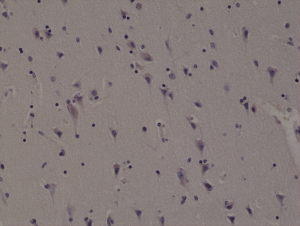anti-ALK (human) Rabbit Monoclonal (RM361)
| Code | Size | Price |
|---|
| REV-31-1247-00-R100 | 100 ul | £455.00 |
Quantity:
Prices exclude any Taxes / VAT
Overview
Antibody Isotype: Rabbit IgG
Antibody Clonality: Recombinant Antibody
Antibody Clone: RM361
Regulatory Status: RUO
Target Species: Human
Applications:
- Immunohistochemistry (IHC)
- Western Blot (WB)
Shipping:
Blue Ice
Storage:
+4°C
Images
Documents
Further Information
Alternate Names/Synonyms:
ALK Tyrosine Kinase Receptor; Anaplastic Lymphoma Kinase; CD246
Concentration:
N/A
EClass:
32160000
Form (Short):
liquid
Formulation:
Liquid. 50% Glycerol/PBS with 1% BSA and 0.09% sodium azide.
Handling Advice:
Avoid freeze/thaw cycles.
Immunogen:
A peptide corresponding to the C-terminus of human ALK (Anaplastic lymphoma kinase).
Long Description:
Recombinant Antibody. This antibody reacts human total ALK protein including ALK fusion proteins. Applications: WB, IHC. Source: Rabbit. Liquid. 50% Glycerol/PBS with 1% BSA and 0.09% sodium azide. ALK was a novel receptor tyrosine kinase (RTK), having an extracellular ligand-binding domain, a transmembrane domain, and an intracellular tyrosine kinase domain. While the tyrosine kinase domain of human ALK shares a high degree of similarity with that of the insulin receptor, its extracellular domain is unique among the RTK family in containing two MAM domains (meprin, A5 protein and receptor protein tyrosine phosphatase mu), an LDLa domain (low-density lipoprotein receptor class A) and a glycine-rich region. Following binding of the ligand, the full-length receptor ALK dimerizes, changes conformation, and autoactivates its own kinase domain, which in turn phosphorylates other ALK receptors in trans on specific tyrosine amino acid residues. ALK phosphorylated residues serve as binding sites for the recruitment of several adaptor and other cellular proteins, such as GRB2, IRS1, Shc, Src, FRS2, PTPN11/Shp2, PLCγ, PI3K and NF1. Other reported downstream ALK targets include FOXO3a, CDKN1B/p27kip, cyclin D2, NIPA, RAC1, CDC42, p130CAS, SHP1 and PIKFYVE. Phosphorylated ALK activates multiple downstream signal transduction pathways, including MAPK-ERK, PI3K-AKT, PLCγ, CRKL-C3G and JAK-STAT. The receptor ALK plays a pivotal role in cellular communication and in the normal development and function of the nervous system. Oncogenic ALK is expressed and used as a marker in anaplastic large-cell lymphomas (ALCLs) and non-small-cell lung cancer (NSCLC).
NCBI, Uniprot Number:
Q9UM73
Package Type:
Vial
Product Description:
ALK was a novel receptor tyrosine kinase (RTK), having an extracellular ligand-binding domain, a transmembrane domain, and an intracellular tyrosine kinase domain. While the tyrosine kinase domain of human ALK shares a high degree of similarity with that of the insulin receptor, its extracellular domain is unique among the RTK family in containing two MAM domains (meprin, A5 protein and receptor protein tyrosine phosphatase mu), an LDLa domain (low-density lipoprotein receptor class A) and a glycine-rich region. Following binding of the ligand, the full-length receptor ALK dimerizes, changes conformation, and autoactivates its own kinase domain, which in turn phosphorylates other ALK receptors in trans on specific tyrosine amino acid residues. ALK phosphorylated residues serve as binding sites for the recruitment of several adaptor and other cellular proteins, such as GRB2, IRS1, Shc, Src, FRS2, PTPN11/Shp2, PLCgamma, PI3K and NF1. Other reported downstream ALK targets include FOXO3a, CDKN1B/p27kip, cyclin D2, NIPA, RAC1, CDC42, p130CAS, SHP1 and PIKFYVE. Phosphorylated ALK activates multiple downstream signal transduction pathways, including MAPK-ERK, PI3K-AKT, PLCgamma, CRKL-C3G and JAK-STAT. The receptor ALK plays a pivotal role in cellular communication and in the normal development and function of the nervous system. Oncogenic ALK is expressed and used as a marker in anaplastic large-cell lymphomas (ALCLs) and non-small-cell lung cancer (NSCLC).
Purity:
Protein A purified.
Source / Host:
Rabbit
Specificity:
This antibody reacts human total ALK protein including ALK fusion proteins.
Transportation:
Non-hazardous
UNSPSC Category:
Primary Antibodies
UNSPSC Number:
12352203
Use & Stability:
Stable for at least 1 year after receipt when stored at -20°C.



